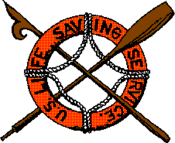Lifesaving Service

Seal
|
|

Pennant
|
|
| Agency overview | |
|---|---|
| Formed | 1878 |
| Dissolved | 1915 |
| Superseding agency | |
| Jurisdiction | Federal government of the United States |
| Agency executive |
|
The United States Life-Saving Service was a United States government agency that grew out of private and local humanitarian efforts to save the lives of shipwrecked mariners and passengers. It began in 1848 and ultimately merged with the Revenue Cutter Service to form the United States Coast Guard in 1915.
The concept of assistance to shipwrecked mariners from shore based stations began with volunteer lifesaving services, spearheaded by the Massachusetts Humane Society. It was recognized that only small boats stood a chance in assisting those close to the beach. A sailing ship trying to help near to the shore stood a good chance of also running aground, especially if there were heavy onshore winds. The Massachusetts Humane Society founded the first lifeboat station at Cohasset, Massachusetts. The stations were small shed-like structures, holding rescue equipment that was to be used by volunteers in case of a wreck. The stations, however, were only near the approaches to busy ports and, thus, large gaps of coastline remained without lifesaving equipment.
Formal federal government involvement in the life saving business began on August 14, 1848 with the signing of the Newell Act, which was named for its chief advocate, New Jersey Representative William A. Newell. Under this act, the United States Congress appropriated $10,000 to establish unmanned life saving stations along the New Jersey coast south of New York Harbor and to provide "surf boat, rockets, carronades and other necessary apparatus for the better preservation of life and property from shipwreck on the coast of New Jersey ... ." That same year the Massachusetts Humane Society also received funds from Congress for life saving stations on the Massachusetts coastline. Between 1848 and 1854 other stations were built and loosely managed.
...
Wikipedia
